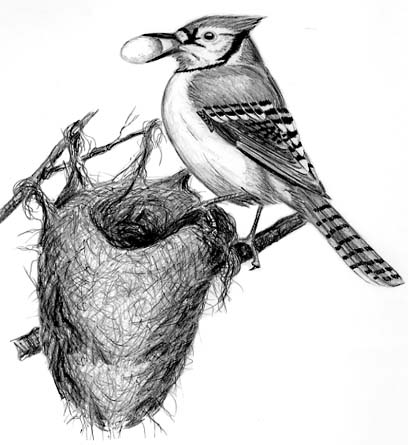
Dear Bird Folks,
You have to tell me what is going on with the Blue Jays. Most of the time they are mellow visitors to our yard. Now, all of a sudden, they have gone psycho. They have attacked an oriole’s nest and just today I saw one attack a young bird that was sitting on our feeder. Where is all of this anger coming from?
-Jackie, Eastham
I’m Not Sure Jackie,
But my theory is that the jay’s anger has to do with the time of year. It’s summer, it’s hot, it’s crowded, there are lines at every bird feeder, the birdbaths are filled by noon, many of the cheaper roosts don’t have air-conditioning, the kids are home from school, and they probably have a nest full of company. Of course the jays are going to be psycho. Why should they be any different than the rest of us?
The handsome Blue Jay would be one of America’s favorite birds if it wasn’t for two minor things. First, they can be very loud. Jays love to announce their presence. They often land near a feeder screaming like it’s the beginning of Armageddon. I don’t want to speak for the jays, but it appears as if they actually enjoy watching the other feeder birds flee for their lives. You can almost hear them say “Dopes, they fall for that fake scream every time.” To a jay, that joke never gets old.
The other thing that many find offensive is their dietary choices. Jays are like us, omnivorous. We eat anything we can put Ketchup on and so do they, only without as much Ketchup. Jays eat fruit, so do we. Jays eat nuts, so do we. Jays eat insects, so do we, although mostly by accident. Jays eat meat, so do we. Yet, it is the idea that jays eat meat, just like we do, that many people find upsetting. The difference is we get our meat from Stop and Shop, while the jays get their meat out in the wild, or in this case, your backyard.
Many birds are feeding specialists. They are programed to eat a particular food and obtain it in a particular manner. Swallows swoop around for insects, gannets dive for fish, finches cling to plants for seeds, shorebirds dig for those wormy things in the mud. There is very little chance youÕll ever find a sandpiper feeding on a blueberry bush or cracking open a seed. Jays on the other hand aren’t so fussy. They’ll take advantage of whatever food source presents itself. When the acorns ripen in the fall, the jays are happy to eat acorns. In the winter they’ll hunt for seeds. In the spring they’ll gladly eat the plentiful bugs. The summer offers them another food source; nests filled with yummy eggs and succulent baby birds.
The “psycho” Blue Jay that you are seeing in your yard is only exploiting a new and abundant food source, like my kids do when they find the candy dish at their aunt’s house. Hawks and owls eat birds all the time, but the idea of one songbird eating a fellow songbird doesn’t seem to sit well with the general public. In fact, I heard of one lady who was so upset when she saw a jay eating another bird that she nearly dropped her bucket of Kentucky Fried Chicken. I’ll admit that it’s tough to watch a jay carry off a baby oriole, but the jays aren’t doing it to be mean or hateful. For the most part they are only providing food for their own nestlings.
Jays aren’t alone. Other birds, including crows and grackles, also become “psycho” during the baby birds season. We should also keep in mind that the number of nestlings taken is small. Some estimates are as low as one percent of a jay’s summer diet. That certainly is small compared to the number of songbirds that are lost to my old nemesis, the uncontrolled house cat.
The other thing to remember is that the ever vigilant jays hate other predators. Every creature in town is alerted when the big mouth jays spot a predator. By sounding the alarm, jays save far more birds than they will ever consume.
And believe it or not, Jackie, the victim birds learn how to deal with the jays and their attacks. Early one spring a young and inexperienced Baltimore Oriole built a nest on an exposed branch of a Pitch Pine. The jays easily found the nest and enjoyed the eggs. The orioles didn’t complain to the bird union or call a lawyer, they simply re-nested in a tree that had thick cover. The jays didn’t find the second nest and the young orioles learned a lesson about proper nest placement, proving that sometimes even “psychos” have a purpose, which is lucky for me.